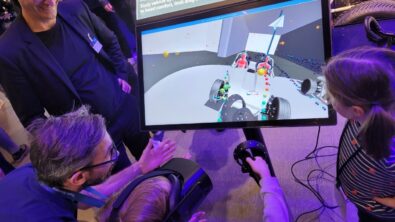Simcenter VR – Why CFD Engineers need it in 2020

Simcenter STAR-CCM+ Virtual Reality
In the beginning, there was the CAVE. The CAVE Automatic Virtual Environment, where you could interact with your simulation data in a multi-walled immersive environment. It was first realized long, long ago in ’92 [1]. This was real pioneering work based on even earlier research efforts going back decades [2]. For virtual reality (VR) to be believable, you need to maintain the sensory illusion of being really “immersed”. I’ve had hands-on experience with VR for over fifteen years. I only rarely felt it in my gut. The ascent of VR needed a technology disruption. The Oculus Rift and the HTC Vive VR headsets made their commercial production release debuts within a week of each other just about two years ago. Gut check.
Who needs it? You do, already…
I’ve been asked: “Why should I care about Simcenter STAR-CCM+ Virtual Reality? I hear that this is going to change how we work with, how we learn from, and how we share our simulation results with collaborators. What can this do for me that I can’t already do with my mouse and keyboard today?”
Let’s look at this turbine blade with internal cooling passages. We can print this part using additive manufacturing; we can hold it in our hands. What we can’t easily do is see inside it. In this fly-through, you can quickly understand the complexity of these internal passages. While we’re checking out the geometry we can also look at the result of all our meshing operations – was our surface wrap good everywhere, do we still need mesh refinement? All of this takes about a minute or two.
Next step, we can release massless particles to watch the flow patterns in different parts of the cooling passages. It’s another few short minutes to identify recirculation zones that could adversely affect performance. Could you do all this with your mouse and keyboard in that amount of time? Not a chance.
Let’s look at this simulation of an underground platform fire (kind thanks to Erwin Schnell, HBI Haerter AG for sharing this dataset). This scenario has some real life-and-death implications. Can people trapped in this situation find exit signs and make their way to safety? With Simcenter STAR-CCM+ Virtual Reality, there’s a wealth of information in your hands. Massless particles released at the train car where the fire is show chaotic flows at platform level, opposing the direction of vented air. Walk along the platform, in complete safety, to the nearest exit and set up a few persistent massless particle emitters (kind of like roadside flares). Steal a glance upward along your way to see the flow is much faster where the ceiling fans are. Walk back to the fire source, and when you look towards the exit you just marked, you can’t see it! The animation here doesn’t do Simcenter STAR-CCM+ Virtual Reality justice – I can tell you from experience that watching these particles disappear from my view, as I feel progressively trapped in this underground station, still sends an eerie chill down my spine. It looks real because it feels real.
I can hear some of you saying, c’mon Matt, this is still a gimmick. We are going to look at our reports and make our decisions. Sure, everyone just knows there is strength in numbers, right? Let’s look at this under hood simulation. We can get a report to tell us what and exactly where the maximum temperature is. OK, what’s the second hottest spot? Even if it is just one degree lower, and in a totally different location, our maximum report doesn’t tell us that. With Simcenter STAR-CCM+ Virtual Reality, you can look all around this engine compartment, in well under a minute. You could even fly along the cooling circuit from the CACs right into the engine block.
VR technology has reached a tipping point both in terms of performance and in price. A CAVE these days costs in the range of $150,000 to $500,000 USD, and it needs to be maintained. Don’t get me wrong, CAVEs still can add value, particularly when it comes to collaboration. But, you can get an HTC Vive Headset on Amazon today for $600 USD. Prices are going to go down. Headsets are going to get lighter and are already going wireless. Fair disclosure here, you’ll also need a decent graphics card – we currently recommend the NVIDIA Quadro P4000 or better. We’re delivering the first production release of Simcenter STAR-CCM+ Virtual Reality, our immersive virtual reality client, with Simcenter STAR-CCM+ v13.02, at no extra cost. With it, you can read standalone scene (.sce) files or connect to Simcenter STAR-CCM+ directly and immerse yourself in any scene within your .sim file.
Just a few short years ago, there was no HTC Vive. Imagine where this technology is going to go in the next few years. Believe me, we have and we’re not going to tip our hand just yet on what is coming next with Simcenter STAR-CCM+ Virtual Reality. Stay tuned, this story is far, far from over. For additional technical details and requirements, please visit our website.
- Cruz-Neira, Carolina, et al. “The CAVE: audio visual experience automatic virtual environment”, (1992) Communications of the ACM, 64-72.
- Sutherland, Ivan, The Ultimate Display, Proceedings of IFIP Congress, pp. 506-508, (1965). Retrieved from http://worrydream.com/refs/Sutherland%20-%20The%20Ultimate%20Display.pdf



Comments
Comments are closed.